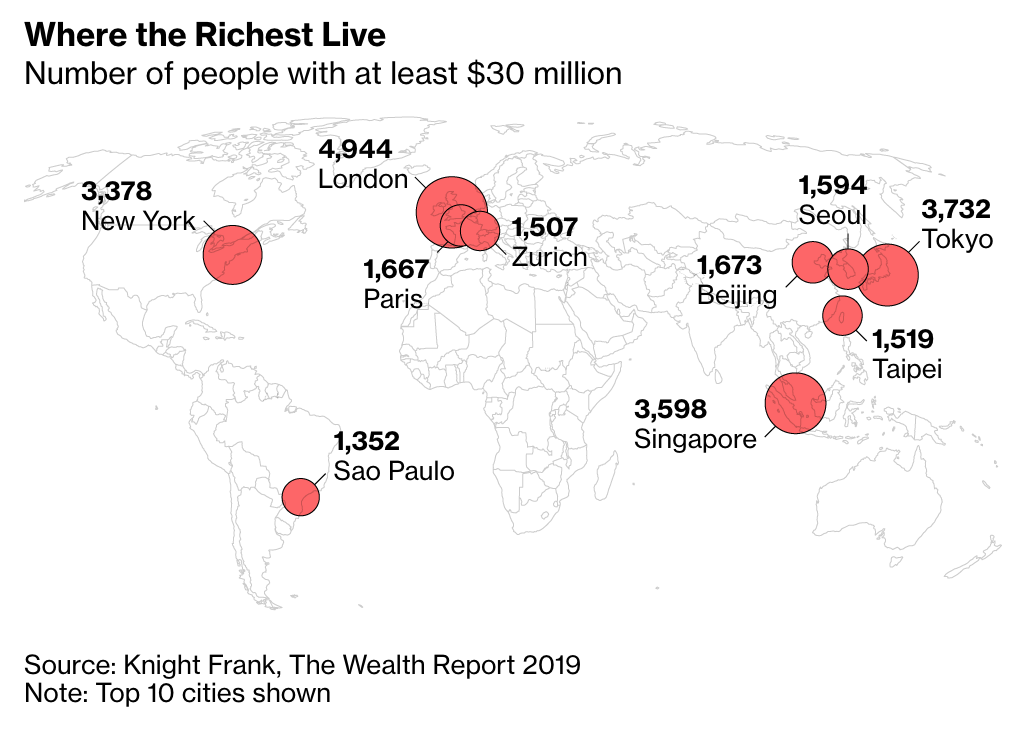
Here’s Where to Find the World’s Super Rich, From Paris to Tokyo


With Friday’s closing bell just around the corner, US stocks look set to rack up a series of unfortunate milestones around winning and losing streaks.
• A lower close for the S&P 500 today means the benchmark has fallen every day this week for a cumulative drop of about 2.4 per cent. That would rank as its worst weekly performance since December 21, just before the market bottomed.
• The index is likely to close lower for the eighth time in nine sessions, but the five day losing streak it is likely to chalk up will rank as the longest since mid-November.
• Subsequently, global stocks are set for their biggest weekly drop since December 21, too. The FTSE All World index has retreated 1.2 per cent over the past five sessions.
• Benchmark US Treasuries are set for their biggest weekly rally since early December, as the yield on the 10-year has moved lower every day this week for a cumulative drop of 13.54 basis points to 2.6177 per cent. The previous time yields had fallen for five consecutive sessions was late November.
• Data showing the weakest pace of US jobs growth since 2017 knocked the dollar on Friday. The DXY index, which tracks the buck against a basket of global currencies, looked set to end a seven-session winning streak that had been its longest in a month.
• Speaking of losing streaks, step up to the plate the Dow Jones Transportation Average. The price-weighted gauge is down 0.7 per cent on Friday afternoon and looks set for a record 11th consecutive decline.
The Dow Transports is often regarded by Wall Street as a predictor of growth given its composition of railroad operators, shipping companies and airlines that ship physical goods around the world. On Thursday, it fell for a record-equalling 10th straight session.
• Indices including the S&P 500, Nasdaq Composite and FTSE All World all closed below their 200-day moving averages, seen by traders as long-term support levels.
• While the three main measures of US stocks all remain less than 10 per cent away from their record highs, the small-cap focused Russell 2000 has fallen back into correction territory. It is down 12.7 per cent from its August 31 peak.
Argentina’s central bank hiked its benchmark interest rate by the most in six months on Friday in a move aimed at propping up the peso, a day after the currency fell to a record low.
The central bank sold short-term Leliq notes in two auctions at an average yield of 57.89 per cent, taking the benchmark interest rate up 600 basis points from 51.86 per cent on Thursday.
The move, which takes interest rates back to their highest level since mid-January — helped stem demand for dollars, allowing the peso to recover to around 41.2 per dollar after sliding to a record low of 43.4 per dollar on Thursday.
The peso has come under pressure in recent weeks as concerns grow that a sluggish economic recovery and fast inflation could sully President Mauricio Macri’s chances for re-election this year.
The central bank has been struggling to sustain the exchange rate over the past week as concerns about the economy and a looming presidential election spur people to switch to dollars. A slower-than-expected recovery from recession and inflation that is running at annualised pace of nearly 50 per cent are also denting Macri’s chance of winning a second four-year term this October.
Economists warn that the central bank’s decision to hike rates, while still down from peak of more than 70 per cent in October, are hurting the economy, with companies struggling to borrow and consumers putting off large purchases. According to a monthly survey of economists by the central bank, the economy is on track to contract 1.3 per cent and inflation slow to 32 per cent this year, with the peso weakening to 48 per dollar.
